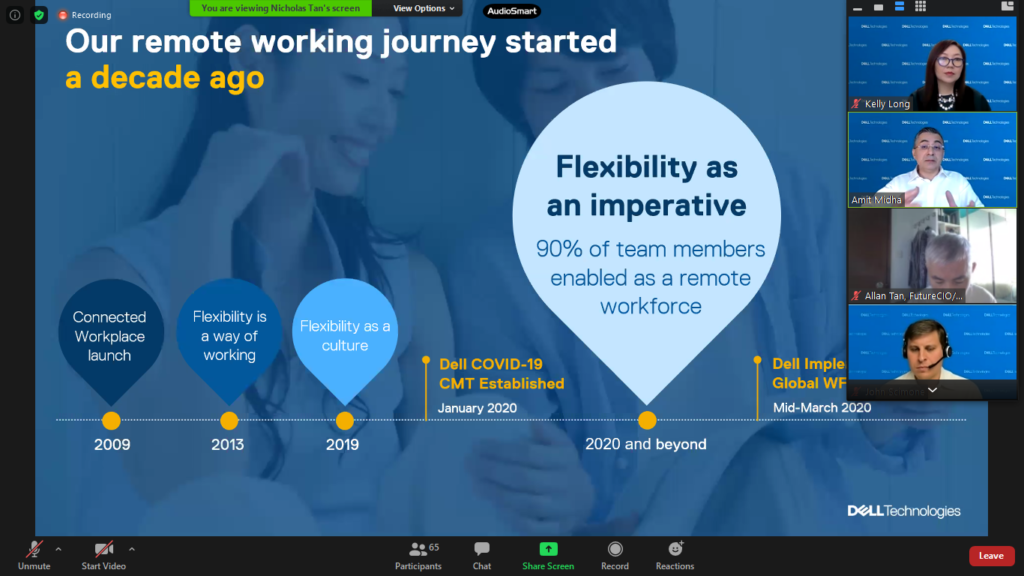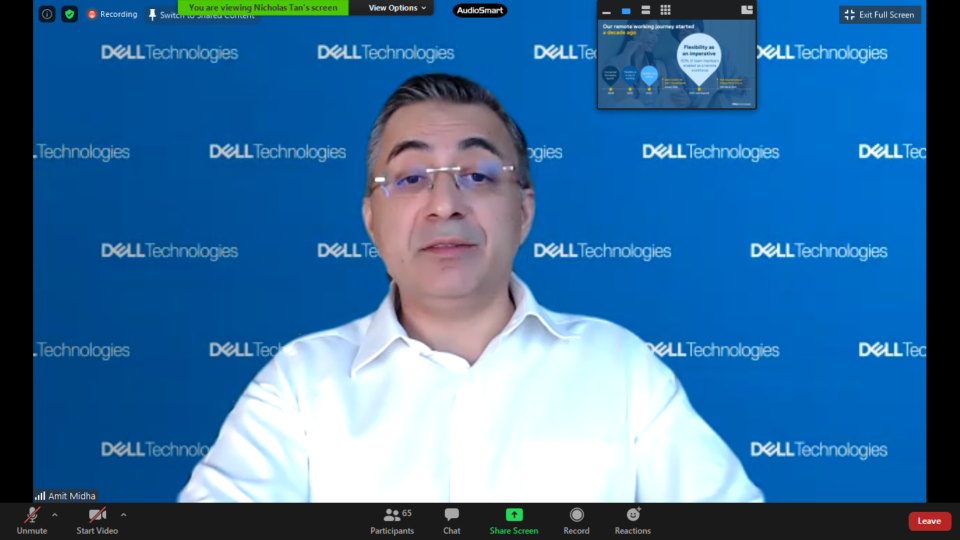Amit Midha, President, Asia Pacific & Japan & Global Digital Cities at Dell EMC
Our world is going through unprecedented changes and it is impacting every aspect of life. What we have experienced is require all of us to pivot in many ways to keep our economy and lives going and still be able to progress forward. I think a lot of these things are being called as the giant social experiment. And again, time will tell how we’ll manage through this.
Amit Midha, President, Asia Pacific & Japan & Global Digital Cities at Dell EMC, said, “Coming back to Dell as a technology company we have had front row seat to overnight digital transformation of our world. One of the most dramatic and drastic change we have seen in how we work. Government, education and healthcare industries had to operate virtually in many cases for the first time virtually and now work from anywhere is becoming more permanent fixtures wherever the jobs allow this.”
Midha acknowledges the shift from response to recovery and admits that quick overnight technology transformation is significant as he says, “We must take these learnings forward as we reshape the future of the world. We have to embrace innovation and allow it to happen anywhere. Give people the tools they need and prioritize flexibility as a permanent fixture. Our values in technologies are there to develop new ways of engagement, pro activity and we have to learn from this nomad generation if we can call it as such.”
Dell is committed to support its customer transition with health and safety at the same time compliant with the governments. Therefore, Dell, as a company, has built flexibility into it culture for the last decade and can create a better work life balance for its people.
Before March of this year Dell had about 30% of its team members working remotely on any given way and 65% of the team members were of opening to take advantage of flexible work environment. In mid-March the company shifted 90% of the workforce to remote. But in long run the company is planning to put as (+) 50% of workforce in remote environment.
Midha maintained, “We must continue to re-imagine work not as a place and time but as an outcome. And we must invest in emerging technology to propel society forward to be resilient in the face of whatever brings in. And if nothing else we may become more human along the way as well. I think we may learn to empathize better. These challenges that even in the opening some of you were mentioning, we do not know what day it is, what time it is, those things are very common.”
One of the recent reports talked about that they work hour has gotten longer and the number of meetings has increased. This is going to create different kind of stress and different kind of challenges for our people.
Dell as a technology company has resolved to be there for the people and that is what the commitment as a company it is making that it is not just about a device it is also about creating the whole system to be able to help them try no matter how and where they would like to work. Midha concludes, “It is also our commitment to customers to make sure that we can support them in providing essential services that they are providing for making sure society moves forward.

John Scimone, Senior Vice President, Chief Security Officer, Dell Technologies, added, “The core guiding principle for all our efforts with the company is really to prioritize the health and safety of our team members, our customers and our communities. We found that we needed to implement globally scalable systems to give us that consistency, to leverage the advances that are available in data science to make sure we are making the best decisions on a daily basis for our team members, our customers and our communities as a whole.”
“We have created a tool with the help of Dell’s own bright data scientists. It is updated daily and pulls from over 15 different key variables that the medical professionals’ advice or the most pertinent and relevant data points to inform health risk judgments. Uses linear regression analysis to monitor curvature, trends and we also have increasingly some productive qualities about it so we can have foresight in our decision-making. And most importantly it’s globally consistent for the company across the globe measuring data across 188 countries in which we operate or travel to,” he added.
We also take into account local conditions – local regulations, government policies. We have local leadership involved at the country and site level, tied into the local policy makers, the rules, regulations. We’re looking at things like our schools back, will our employees be facing a challenge potentially if schools aren’t back but they are going back the office? We factor all of those local conditions in and make sure that local conditions on the ground are prudent for us to bring employees back.
And then when we do start bringing employees back, we don’t just bring everybody back overnight. We’ve actually gone through the process of phasing out and prioritising all of the roles that we have based on the necessity and importance of them coming back on site, either for productivity reasons or in the rare instances that we find that team members may have local hardship conditions in working remote, whether it may be internet connectivity or other considerations where we need to bring them back into the office to make sure that they’re safe and enable the employee to be productive.
Dell Technologies was recently ranked No. 4 out of 100 companies on Fast Company’s Best Places to Work for Innovators. Midha added, “We are very proud of that. We know the transition back to site might be difficult, but this is also an opportunity for us to further reinvent and redefine work. We must continue to reimagine work not as a place and time. We must invest in emerging technologies to propel society forward.”
Despite pushing employees to work from home and remoted places, Dell has received tremendous success. In Australia Dell helped Hydro Tasmania to modernise the IT through a two year digital transformation journey. The OEM empowered them with the capability to move their entire 1,400 strong workforce to remote working. These implementations were done during the lockdowns.
In Korea Dell helped HanaTour with the adoption of Next Gen Hybrid Cloud for business efficiency and agility. Now they’re able to embark on some of the applications… development projects for new services more quickly. And the time to market has been slashed pretty dramatically as well. In Philippines, with empty digital overhaul through workforce transformation started 2 years back. But what benefit was is, they were able to do business as usual through the lockdown as well.
in India Dell worked with very large life sciences companies to help ramp up testing facilities for COVID-19. The company implemented virtualised environment for global testing operation and to centrally monitor and maintain control over data governance. In Japan an IT services company was tasked by the government to help manage the nation’s financial relief program for SMEs. Midha maintained, “We supported them through efficient supply chain and DFS solution. DFS is our financing solution that we are offering to both customers and partners.” One of the largest banks in Asia needed all their 5,000 staff to work from home to continue operating their banking essential services remotely. And the VDI technology was chosen and Dell have been able to provide those expanded workloads for expansion of their existing infrastructure that Dell had provided, plus also the Next Gen devices.
Midha said, “I think there are more used cases that we cannot share, but they are yet to come. As we return to site, as we learn to coexist with the virus, as we move away from containment and mitigation to coexistence mode for this virus or even prepare for what may be next, I think there will be new used cases coming up. What is clear is that digital penetration of services is going to be expanding exponentially, and what we see is that people are continuing to be going to invest in ways to not only take advantage of the data, but also be able to prepare for additional used cases; some of them I have mentioned, but there are more to come.”
Apart from technology short supply, there was a contraction of finance too; but the customers and partners have been vocal about their need for flexible financing, financial services that can support the digital transformation. In April Dell launched its PFP – Payment Flexibility Program and announced 9 billion in financing to help fund their critical technology needs.
Under the PFP program, Dell even pursued payment deferrals until 2021. This program in the region is available in ANZ Japan and Singapore. Dell is also working through other financing partners to find solutions for its customers and partners as well.
Finally…
Dell believes in continuous support to its customers and provide essential services they need, while keeping its team members safe. Midha concludes, “We’re going to continue to innovate to the new way of doing work, which is not tied to a place and time, but driven by an outcome. We also have to think about how we can get new challenges, whether it’s about additional attack that comes in, whether it’s about social distancing, whether it’s about masking, all of those things we have to think about as well. In addition to that, how do we make sure we are being part of the solution in terms of creating the right policy and right support infrastructure for our people, for tiredness or fatigue or other things that we haven’t foreseen yet.”
In essence, Dell’s vision is to create essential infrastructure that drives the human progress and therefore takes its role very seriously and shows commitment to a society which creates digital future for all of us again.


